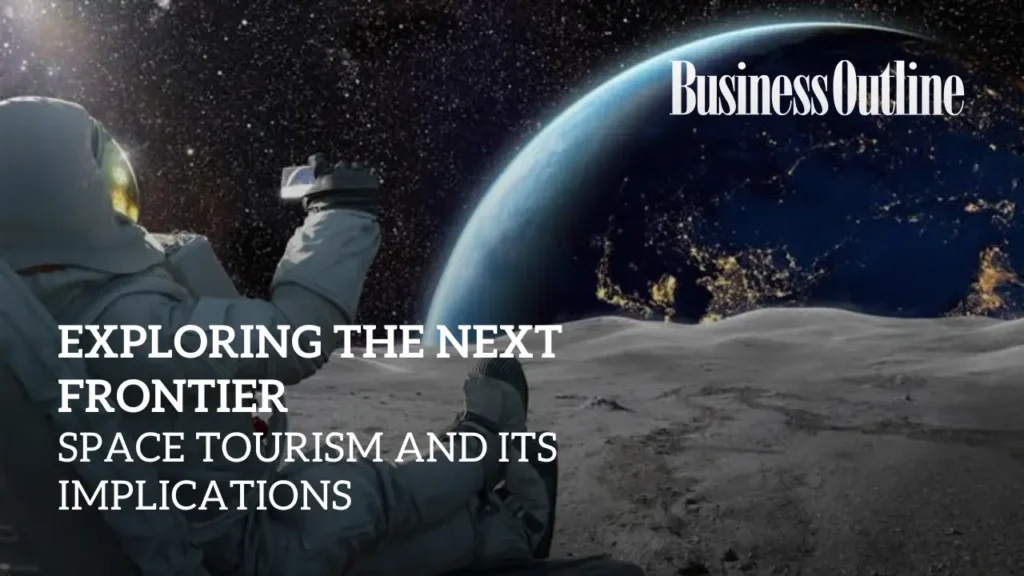By- Jaya Pathak
Exploring the next frontier: Space Tourism and its implications
Space tourism is that segment of aviation industry which gives tourist and experience of travelling this space for business or recreational purposes. After crossing the Karman line, the space travel begins. It is a line which is considered as the boundary between the atmosphere of earth and the outer space. It lies nearly 100 kilometres altitude from earth. n aircraft flies below this altitude while our spacecraft crosses the Karman line.
It was started In April 2001 the American businessman and engineer Dennis Tito become the first ever space tourist to travel to space.
Space tourists are given training for fast exploration or g forces in a centrifuge and weightlessness by flying in a high altitude jet plane doing parabolic arcs. They have to learn how to operate and fix the parts of spaceship using simulators.
History of Space Tourism
The history of space tourism dates back to 2001 when the American businessman and engineer Dennis Tito became the first ever space tourist to travel to space. 7 space tourists took eight space flights to the International Space Station between 2001 to 2009.
Anousheh Ansari Became the 1st female space tourist in September 2006. She is an Iranian American businesswoman. It took around 20-25 million dollars per trip. In 2007 space tourism emerged as a growing market for commercial spaceflight.
In 2010, due to an increase in the International Space Station crew size, it halted its orbital space tourism. the orbital tourism of Russia resumed with the launch of Soyuz MS-20 in 2021.
The cost efficient space programs Israel is increasing accessibility for a wider range of participants. The Indian government is encouraging private participation in the space sector. Initiatives are launched by the organization beat it the supportive policies are able to attract investments and innovations. PSLV C 53 is one of such examples which emerged as the first official public private collaboration for a space launcher in India. Companies such as SpaceX and Blue Origin have invested in the Indian space tourism sector.
Types of Space Tourism
- Sub orbital Spacecraft: Passengers are taken to the edge of space to experience weightlessness for a few minutes. After going just beyond the Karman line, day come back to earth.
- Orbital Spacecraft: Passengers are taken into orbit around the earth so that they can see the planet from space and experience weightlessness for a longer period of time than in the suborbital spacecraft.
This space tourism industry is blooming as the demand is growing rapidly. It is expected by the experts that it will continue to expand at an annual growth rate of 40.2% from 2023 to 2030. Global space tourism market was valued at US $695.1 million in 2022 which is likely to reach 8,669.2 million by the end of 2030.
As per a report by the Federal Aviation Administration predicted that space tourism industry has become a billion dollar market within 20 years.
According to a report by Research and Markets, the global tourism industry is projected to reach 8.67 billion dollars by 2030 with an estimated CAGR of 37.1% between 2022 and 2030.
Challenges affecting space tourism
- Spacecraft and rockets lodging require a plenty amount of energy which produces air as well as noise pollution.
- The emissions by rockets and space crafts are bringing climate change and harming the atmosphere.
- Even in the present time, space to reserve is quite expensive which is accessible only to the wealthy people. Sense a large amount of people will not be able to experience this journey it will create a feeling of elitism and inequality.
- The lodge of spacecraft generates debris which can stay in the orbit for longer period of time. It can cause problems to other spacecrafts and can even damage them.
- A vast number of resources as required by the space tourism including fuel, energy and materials. The depletion of these resources is causing long term consequences and are equally negatively impacting the environment. Since the resources are quite limited to us therefore there is an equal need to restore it for future generations.
- There is a legal challenge which is affecting space tourism. Experts are concerned about the impact of space tourism on International Space laws and the treaty on principles governing the activities of states in the exploration and use of outer space including the moon and other salacious bodies. This treaty was signed in 1967. It is a multilateral treaty which stood as the basis of International Space law.
Conclusion
Undoubtedly, Space Tourism is revolutionising the aviation sector. It is opening new opportunities and experiences which no one have ever imagined. It will play a significant role in exploring the space. But it is posing certain challenges which needs to be overcome. These challenges need to be addressed at a broader spectrum.


